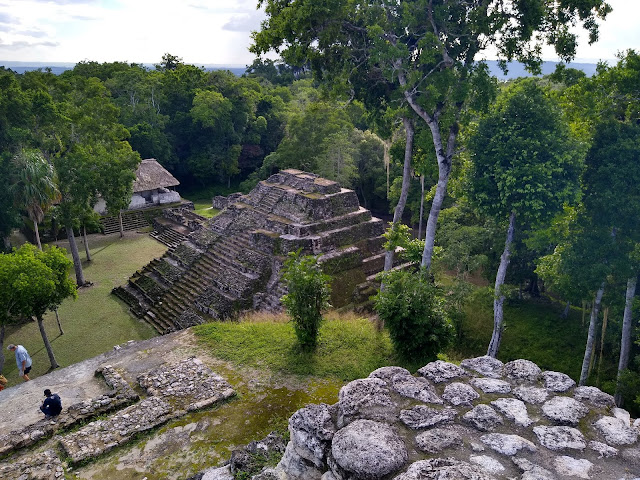Decades ago, I remember being fascinated by a film, "Chariots of the Gods", which introduced me to the marvels of the ancient Maya civilisation. We had already visited a few minor sites in Belize, but I was not going to pass by the chance to visit the magnificent site at Tikal whilst we were in Guatemala.
As we have so many boat jobs to get through we opted to use a tour to make the visit, traveling with a small group of fellow cruisers. Ernesto, our bus driver was happy to adapt our schedule to accommodate opportunities along the way, here departing the Rio.
The first Maya Cities developed around 750 BC but it was not until 250 AD, the Classic period is largely defined as when the Maya were raising sculpted monuments with long count dates. This is when the Maya civilisation develops into one with many city-states linked by a complex trade network. In the Maya Lowlands two great city rivals emerged, Tikal and Calakmul. In its heyday, between about 200 and 900 AD Tikal was a flourishing city of almost 100,000 citizens. To date, only the major structures have been excavated and prised from the rampant rain forest that envelops the site.
Our first Maya visit was actually to a neighbouring, little-visited site: Yaxha. We were almost the only visitors that afternoon, and there was a sense of adventure as we explored through the rain forest, screamed at by the howler monkeys in the treetops.
Our guide usefully indicated which temples were safe to climb up ( we would probably have missed out on doing this without his guidance), to give us beautiful views over the treetops to the lake beyond.
We were lucky to be able to squeeze in a boat trip across the (apparently crocodile infested) lake to a small island where a meandering path took us through more Maya ruins. The return trip gave us a special sunset over the lake.
Whilst the towering temples totally lived up to expectations and were both beautiful and impressive, .....
It is said that the Mayans were a peaceful civilization. Clearly investing so much money in temples meant they were religious people too, so much so that it was universally considered an honour to die. It was, therefore, the winners of the game and not the losers that were sacrificed on special and handily located small round altars. The captain of the losing team would have the lesser honour of performing the sacrifice. The blood of the victims mixed with wood and burnt, sending their souls to the upper world. All seemed clear until a second guide explained that the winning captain decapitated the losing captain. Luckily we have moved on a bit from these times but religious beliefs between unconnected civilisations seem remarkably linked, with similar stories of underworlds, re-incarnation, and heaven and privileges for martydom.
There was Carved pictorial evidence of victims being trussed up and decapitated.
Along with our visit to the sites, we stayed close by to the attractive town of Flores, built on an island in the lake. Our hotel was a short walk across a causeway to the town - and we enjoyed a couple of evening meals here - though my inadvertent choice of chicken gizzards for dinner was chewy and disappointing!
A quick visit to some limestone caves, huge and bat-infested, rounded off an enjoyable minibreak before returning to the reality of the boatyard.
..and this is what we had to resolve when we got back















No comments:
Post a Comment